
UAVs or unmanned aerial vehicles were originally developed as military tools. Over the past few years, UAVs have found their way into civilian hands through various private entities. Drones are increasingly being used in the media industry and most especially in the film industry. Additionally, some drones are purposely created for recreational uses. As a result, there are growing concerns about privacy and the dangers UAVs pose to human safety. These are all the more reasons to follow the laid down flying protocols and guidelines laid out by the responsible authorities.
Today, however, the UAV landscape is evolving at an alarming rate. This can be attributed to practical factors such as advancements in technology, revised flying guidelines, and flexible regulations. One thing to note is that drones utilize sophisticated technology, though simplistic in nature, are relatively able to accomplish much. While some UAV concepts are still at the infancy stages, the future looks promising for the drones manufacturing industry. Soon, the UAV market is predicted to grow exponentially as a result of public acceptance, and as people’s perceptions and attitudes about drones continue to soften.
With that in mind, let’s take a look at four technical advances and trends in the UAV industry.
1. Unmanned Flight Systems

A majority of the drones you see today are remotely controlled. This means that they can only fly as high and as far as the signal range. Years back, the updated versions of UAVs featured GPS-enabled functions. This meant that the drones could be used on wider open spaces. It also meant that they could be traced and located with ease. But living in a technologically advanced era has its perks. The experts at cp-aeronautics.com believe that with unmanned flight system technology, drones will be able to perform some of the most complex tasks they could not have done years back. In a way, this will help improve service delivery even in the remotest parts of the world. Additionally, it will help enhance surveillance precision and intelligence gathering. Let’s now take a look at how this technology will impact society:
- Improvements in food delivery services – Food delivery companies are using drones to deliver food supplies to their clients. This has in the current situation proved to be a technology worth investing in, especially during quarantines.
- Providing emergency response teams with real situations on the ground – UAVs are outfitted with thermal imaging cameras that help relay accurate data to response teams on the ground making it easier to identify victims in need of urgent help in an emergency situation.
- Delivering aid supplies and disaster relief – When hurricane Harvey struck back in 2017, the medical teams on the ground had a hard time accessing medical supplies. As a result, drones were used to deliver humanitarian aid and medical supplies, and in addition to this, they came in handy in surveying and assessing the situation from an aerial point of view.
- Improved efficiency in the agricultural sector – The use of UAVs in the agricultural sector has helped to boost efficiency in gathering data and in automating agricultural processes that were redundant, time-consuming, and repetitive. This has significantly helped to boost food production.
- Accuracy in weather forecasting – Scientists are using UAVs to analyze cloud patterns in an attempt to provide real-time weather forecasting. The same application is being used to monitor and assess traffic and thus providing motorists with real-time traffic updates on their mobile devices.
2. Sophistication in the Detect-and-Avoid Technology

The drones used for recreational purposes have detect-and-avoid systems but unfortunately, it’s not sophisticated or advanced enough to face the challenges that come with aerial navigation. And this is perhaps the reason why most drones are not permitted to fly at the same height as that of a commercial aircraft. The emerging trends in the UAV industry have seen industrial drones fitted with advanced detect-and-avoid systems that are not only efficient but also very effective. This means that such drones will avoid collisions with obstacles both above and on the ground. This will play a huge impact on reducing accidents and dangers to human life.
3. GPS Location Technology

Modern UAVs will now be able to identify their location even in areas where GPS signals are weak, degraded, or limited. This will make it easier to track a drone’s movements and in case something happens, the location systems will make it easier for you to find your drone using a GPS tracker. This is an important step, especially, when used on drones that deliver humanitarian aid and emergency relief. Among the benefits of investing in a GPS enabled drone include:
- You can avoid the no-fly zones and areas with restricted access
- The ability to fly drones in wide-open spaces
- Improved stability
- Better control
- Improved surveillance
As the COVID 19 epidemic continues to disrupt the lives of millions across the globe, scientists and researchers are using GPS-enabled UAVs in drawing containment plans and recovery strategies using heat mapping technology. When used together, these technologies can help save millions of lives.
4. Integrated ATM (Air Traffic Management) Systems
While this remains a futuristic move, it will allow drones to fly on the same level as a commercial aircraft. The technology will make communication between the air traffic control system and the UAVs much easier. This is in an attempt to minimize accidents in the air and in making drones a safer invention for everyone. But more needs to be done to streamline regulatory and compliance procedures when it comes to UAVs.
Whether you own a drone at home or are aspiring to own one, this is the best time to do so. There has never been a better time to own tech than in this era. Of course, there is no limit to what humans can achieve. The future looks promising in the UAV industry and this will help improve some areas in drone technology that has in the past years proved tough to crack. But most importantly, especially when it comes to privately owned UAVs, it’s important to observe the various regulations, guidelines, and restrictions set by the relevant authorities.







